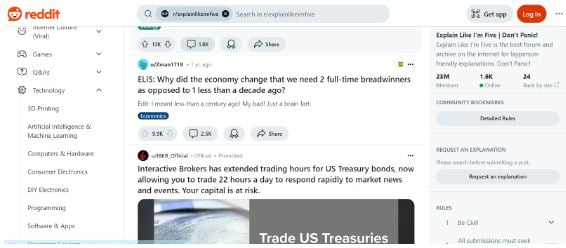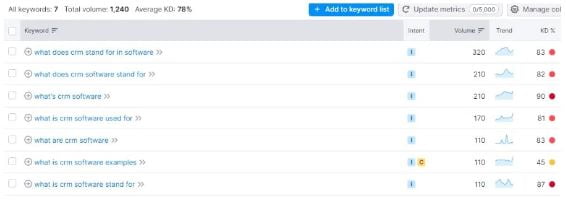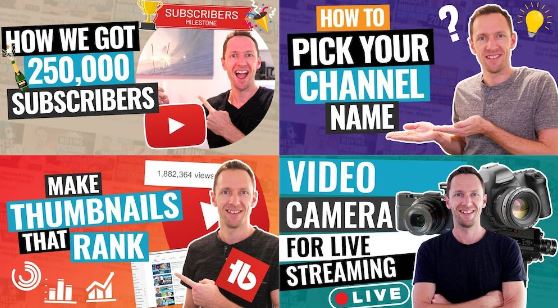With it being such a competitive landscape you need to make sure that you’re ticking every box or risk you’re content getting buried amongst the millions and millions of other creators.
To make sure that’s not you, we’ve pulled together the ultimate YouTube checklist. We’ll walk you through the key ranking factors and what you need to optimise so that the length that time people have watched your video is at least as long as the amount of time you spent making it.
The Key Ranking Factors YouTube Considers When Analysing Your Videos
At its core, YouTube functions much like any other search engine, using a sophisticated algorithm to decide which videos it recommends. Several crucial factors come into play, each influencing how your content is discovered and engaged with by viewers. Here are the main factors YouTube takes into account:
Watch Time: This is the total time viewers spend watching your videos. A higher watch time indicates that your content is engaging and holds viewers’ interest, which YouTube rewards by giving your videos a boost in search results.
Click-Through Rate (CTR): CTR measures the percentage of viewers who click on your video after seeing it in their search results or recommendations. A higher CTR means your video title and thumbnail are hitting the mark, drawing in curious viewers.
Engagement (Likes, Comments, Shares): Engagement metrics like likes, comments, and shares show how viewers interact with your video. High engagement signals to YouTube that your content resonates with the audience, which can increase its visibility and reach.
Video Metadata (Title, Description, Tags): Well-optimised metadata helps YouTube understand the content and context of your video. Using relevant keywords in your title, description, and tags can improve your video’s discoverability by aligning it with viewer searches.
Thumbnail Quality: A visually appealing and informative thumbnail can greatly influence your video’s CTR. Since it’s often the first thing viewers notice, a high-quality thumbnail that accurately represents your content can entice viewers to click.
Session Duration: This factor considers how long viewers stay on YouTube after watching your video. If your content encourages viewers to continue exploring the platform, YouTube is more likely to promote your videos.
Upload Frequency: Regular uploads can keep your audience engaged and show YouTube that your channel is active. Consistency in posting can also foster viewer loyalty and increase overall watch time, which is key to growing your channel.
Our YouTube SEO Checklist to Skyrocket Your Views
While there’s no magic formula to ensure your videos go viral, there are proven strategies you can use to give your content the best shot at success. By following the steps in our checklist, you can optimise your YouTube videos to boost visibility and engagement, helping your channel grow.
Content Planning
Step 1: Keyword and Topic Research
Choosing the right keywords and topics is key to creating content that resonates with your audience and ranks well on YouTube.
Here’s how you can conduct effective keyword and topic research:
Jobs to Be Done (JTBD) Framework: The JTBD framework focuses on understanding the specific needs and pain points of your audience. By identifying the “jobs” your viewers want to accomplish, you can create content that directly addresses these needs. You can also additionally use questionnaires to gather insights into your audience’s challenges and desired outcomes. This approach helps you come up with video ideas that are both relevant and valuable to your viewers. For a breakdown of how to use a JTBD framework effectively check our our post.
Forums and Online Communities: Platforms like Reddit and Quora are goldmines for discovering trending discussions and frequently asked questions in your niche. By diving into these forums, you can tap into the real concerns and interests of your target audience. This insight allows you to create content that provides solutions or answers, positioning your videos as go-to resources.

Tools for Keyword Research and Content Planning
To optimise your content strategy and enhance your search rankings, leveraging specialised tools for keyword research and content planning is crucial. These tools can help you identify popular keywords, trending topics, and search volume metrics. Here’s a breakdown of essential tools categorised for your convenience:
- Keyword Research Tools
SEMRush’s YouTube Keyword Tool: Provides valuable insights into popular keywords and search volume specific to YouTube. Ideal for discovering terms that can boost your video content’s visibility.
YouTube’s Search Bar: Utilises YouTube’s autocomplete feature to find trending and relevant search queries. This tool helps you understand what viewers are searching for and tailor your content accordingly.
- Trend Analysis Tools
YouTube Trends: Monitors trending topics and popular content on YouTube. This tool aids in identifying current trends that can inspire timely and engaging video content.
Google Trends: Analyses search interest over time and geographical locations. Useful for spotting emerging trends and understanding seasonal variations in search behaviour.
- Analytics Tools
YouTube Analytics: Offers insights into your channel’s performance, including audience engagement and content effectiveness. Helps refine your strategy based on actual performance data.
By integrating these tools into your content planning process, you can better align your videos with audience interests and improve your chances of ranking higher in search results.

Step 2: Evaluating Your Ideas
After compiling a list of potential topics and video ideas, the next step is to evaluate them. This involves assessing whether your content will be both relevant and competitive.
Here are some key methods to evaluate your video ideas:
Understanding demand using SEMRush
Tools like SEMrush can help you gauge the popularity and competition level of your chosen keywords. SEMrush provides insights into search volume, indicating how often a keyword is searched for. It also offers a keyword difficulty score, which helps you understand how competitive a term is.
Additionally, SEMrush allows you to see which SERPs (Search Engine Results Pages) return video results. This is an indication that video content is preferred or expected for that particular query, helping you align your content strategy accordingly.
While SEMrush can suggest the search intent (informational, navigational, transactional) associated with keywords, it’s important to interpret this data carefully, as it might not fully capture the nuances of user intent.
Getting a Sense of the Top Ranking Results Using Manual Search
To gain a more comprehensive view, manually enter your identified keywords into Google and YouTube. This allows you to see the top-ranking results and understand the types of content currently favoured by the algorithms. Pay attention to the titles, descriptions, video formats, and presentation styles of the top videos.
In addition, review the number of views each video has to assess the demand for the topic. This helps in understanding not just what users are searching for, but also the level of interest and competition. By combining these insights with SEMrush data, you can better determine both search intent and demand, allowing you to tailor your content to meet user expectations and interests more effectively.
Understanding the Competitiveness of the Results Using YouTube
To gauge the competitiveness of your chosen keywords, consider the size and engagement levels of the channels ranking for those terms. Manually search for these terms on YouTube and observe the subscribers for the top-performing channels. If large, well-established channels dominate the space, it may be challenging for smaller creators to rank. However, niche topics with lower competition might provide more accessible entry points.
Getting a Sense of Video Length Using Manual Search
Video length can significantly impact engagement and ranking on YouTube. Longer videos often allow for more comprehensive content, which can be beneficial for topics that require detailed explanations. However, it’s important to match video length with viewer expectations. By examining the length of top-ranking videos for your chosen topics, you can determine an optimal duration that balances viewer retention and content depth.
Creating a Priority List of Finalised Ideas
After evaluating the potential topics and video ideas, the next step is to prioritise them based on various factors.
This process involves:
- Scoring Each Idea: Assess each idea based on criteria like search volume, keyword difficulty, engagement potential, and alignment with your strategic goals.
- Determining the Importance of Each Metric: Assign weights to each metric according to your content strategy and objectives. For example, if your goal is rapid channel growth, search volume and engagement potential may carry more weight.
- Calculating the Total Score: Multiply each metric’s score by its weight, sum the results, and rank the video ideas from highest to lowest.
- Starting Production with the Highest-Scoring Ideas: Begin with the ideas that score the highest, as they offer the best potential for success. Periodically review and adjust your priority list based on new data and audience feedback to ensure your content strategy remains aligned with viewer interests and market trends.
Production & Upload
Step 3: Video Production
With your key topics identified and video ideas prioritised, it’s time to dive into the production phase. Creating content optimised for YouTube involves balancing both creative flair and technical precision.
Here are some essential points to consider during production to ensure your videos are optimised for the platform:
Creating Videos Optimised for Specific Search Intent
Aligning your video format with the viewer’s search intent is crucial for success. Here’s how to tailor your content to meet specific needs:
- Informational Content: Craft tutorials, how-to guides, or explainer videos that deliver clear, actionable insights. Use visuals and step-by-step instructions to enhance comprehension and engagement.
- Navigational Content: For content that guides viewers to specific information or resources, create walkthroughs or directory-style videos. Provide clear directions and include relevant links to assist viewers.
- Transactional Content: When aiming to convert viewers, such as through product demos or reviews, focus on showcasing features, benefits, and compelling calls-to-action. Include testimonials and evidence to build trust and credibility.
Best Practices for producing YouTube videos
High-quality production values are key to retaining viewers. Here’s a quick list of important technical specifications:
- Resolution: Aim for at least 1080p (1920×1080 pixels) to ensure high-quality viewing and maintain viewer engagement.
- Frame Rate: Choose between 24, 30, or 60 frames per second (fps), depending on the content type and desired aesthetic.
- Bitrate: Follow YouTube’s recommended bitrate settings for optimal quality and manageable file size (e.g., 8 Mbps for 1080p at 30 fps).
- Audio: Use a high-quality microphone to capture clear audio, minimising background noise. Background music can enhance the viewing experience.
- Format: The MP4 format with H.264 video codec and AAC-LC audio codec offers the best compatibility and quality.
- Aspect Ratio: The standard aspect ratio is 16:9, which suits most YouTube videos. Ensure your video adheres to this ratio for optimal display.
- Lighting: Good lighting is essential for clear, visually appealing footage. Use soft, even lighting to avoid harsh shadows.
- Editing: Edit for smooth transitions, clear visuals, and appropriate pacing to keep viewers engaged and enhance content quality.
Strategic Use of Keywords
To maximise the videos chance to rank in YouTubes search place your main keyword early in the video. This strategy not only helps with viewer retention but also signals relevance to YouTube’s algorithm. Additionally, weave related secondary keywords naturally throughout your video to capture a broader audience.
Encouraging Engagement with Related Content
Encourage viewers to explore other related content on your channel. This can be achieved through verbal mentions, annotations, or end screens linking to related videos. Keeping viewers on your channel longer is beneficial for your overall channel performance.
Creating a Compelling Thumbnail

- High-resolution images: Use clear, professional images that accurately represent your content.
- Bold, readable text: Include text that stands out against the background, ensuring it’s easy to read even on small screens.
- Consistent branding: Maintain a consistent style across all thumbnails to reinforce brand recognition.
- Contrasting colours: Use contrasting colours to draw attention and highlight key elements, making your thumbnail more eye-catching.
- Recommended size: Ensure your thumbnails meet YouTube’s recommended size (1280 x 720 pixels, 16:9 ratio) for optimal display across devices.
Step 4: YouTube SEO Upload
The upload process is a pivotal step in optimising your video for search and discovery on YouTube. By following these key steps, you can boost your video’s visibility and relevance, making it easier for viewers to find and engage with your content.
- Add the main target term to the file name: Before uploading, include the main target keyword in your video file name. This helps YouTube understand the content right from the start. For example, if your video is about “digital marketing tips,” name the file something like “Digital-Marketing-Tips.mp4.”
- Add the main target term to the title: The video title is one of the most critical elements for SEO. Make sure the main target term is included to clearly convey the video’s topic. This helps both YouTube’s algorithm and potential viewers to quickly identify the content.
- Add the main term to the first sentence of your description: Start your video description with the main target term to emphasise the relevance of your video.
- Add related terms to the description: Expand your description to include related keywords and phrases. This broadens your video’s reach in search results for various related queries. The real art is doing this while still keeping the description sounding natural, informative, and engaging.
- Select the most appropriate category: Choosing the right category helps YouTube classify your content accurately, which can influence its discoverability in search results and recommendations. Select the category that best matches your video’s content to reach your intended audience.
- Add chapters/segments to your video: Chapters or segments help viewers navigate your video, especially if it’s longer. By including timestamps and descriptive titles for each section, you enhance the user experience. Also, use related target terms in chapter titles for additional SEO benefits.
- Add the main term, related terms, synonyms, and misspellings to the tags Tags are crucial for helping YouTube understand your video’s context. Use a combination of the main target term, related terms, synonyms, and common misspellings. This broadens the range of search queries your video can match, increasing its visibility.
- Enable autocaptions or consider transcribing: Enabling auto-generated captions makes your video accessible to a wider audience, including those with hearing impairments. Additionally, consider providing accurate transcriptions using third-party tools and adding them as subtitles. This not only improves accessibility but also helps YouTube’s algorithm better understand your video’s content.
- Add the video to relevant related playlists: Playlists can significantly boost your channel’s watch time by encouraging viewers to watch multiple videos in one session. Add your video to relevant playlists to keep your audience engaged and help YouTube understand the thematic grouping of your content.
- Consider adding translated subtitles for international audiences: Adding translated subtitles can make your content accessible to a global audience, potentially increasing your reach and engagement. This can also improve SEO for non-English search terms, helping you tap into international markets.
Post-Upload
Section 5: Video Promotion and Post-Upload Optimisation
Promoting your YouTube video effectively is crucial for expanding your reach and maximising the impact of your content. The process involves utilising various channels and platforms to increase visibility, engagement, and overall reach.
Here are some strategies for promoting your YouTube video and optimising it post-upload:
Video Promotion Strategies
- Promote on related social channels: Sharing your video on social media platforms like Facebook, Twitter, Instagram, and LinkedIn taps into your existing audience and attracts new viewers. Use engaging captions and relevant hashtags to boost discoverability and encourage shares, amplifying your video’s reach.
- Cross-promote in related video descriptions: This cross-promotion encourages viewers interested in similar topics to explore more of your content, deepening engagement and potentially increasing your subscriber base.
- Embed videos on your website or blog: Embedding your video on your website or blog can enhance visibility and improve SEO. This approach increases dwell time on your site—a positive signal for search rankings. Additionally, embedding videos in relevant blog posts or articles enriches the content experience for your visitors. You could also look to transcribe your videos and adapt them into blog content for your site, allowing you to make the most of the effort you’ve put into producing the content.
- Include videos in newsletter or emails campaigns: Incorporate your video into newsletters, email campaigns, or customer updates. This targeted distribution ensures your existing customers and subscribers are aware of your new content, keeping them engaged and informed.
- Share in relevant forums and communities: Sharing your video in forums and online communities like Reddit or niche-specific forums can introduce your content to a new and relevant audience.
- Consider promoting it with paid ads: Boosting your video’s visibility with paid ads or PPC campaigns on platforms like Google Ads, YouTube Ads, or Meta Ads can be a great way to initially get your content in front of a wider audience.
Post-Upload Optimisation
- Track keyword rankings: Monitor the ranking of the keywords associated with your video using tools like YouTube Analytics, TubeBuddy, or VidIQ. Tracking these rankings helps you understand which keywords are driving traffic and which need improvement, allowing you to refine your content strategy.
- A/B test thumbnails for higher CTR: If your video has views but a lower-than-expected click-through rate (CTR), experiment with different thumbnails. A/B testing helps you identify which visual elements are most effective in attracting clicks, improving your video’s engagement and ranking potential.
- Analyze search terms in YouTube analytics: Use the search terms report in YouTube analytics to see the exact queries viewers used to find your video. This insight helps confirm whether your targeted keywords are effective, reveals new keywords, and offers deeper understanding of viewer intent, guiding you in optimising your video’s metadata.
- Review video descriptions and tags for missing keywords: Regularly review your video descriptions and tags to ensure they include all relevant keywords. As you gather new data from analytics, you may discover additional keywords to add, enhancing your video’s discoverability and reaching a wider audience.
Conclusion
Successfully navigating YouTube’s competitive landscape requires a well-thought-out SEO strategy. By focusing on keyword and topic research, you can create content that resonates with your audience and stands out in search results. Evaluating your video ideas based on search volume, competition, and viewer intent ensures you’re producing relevant and engaging content.
During the production and upload process, it’s crucial to optimise your videos for both technical quality and SEO. This includes using appropriate keywords in your titles, descriptions, and tags, as well as creating appealing thumbnails and enabling captions. Post-upload, promoting your videos through social media, forums, and paid ads, alongside regular monitoring and optimisation of your metadata, can significantly boost your video’s reach and engagement. By consistently applying these practices, you can enhance your video’s visibility, grow your channel, and achieve greater success on YouTube.

